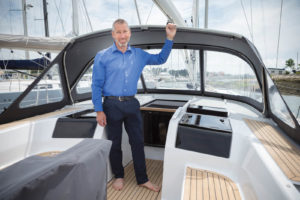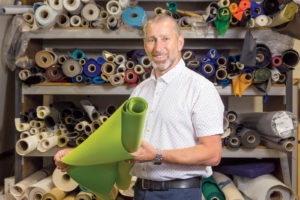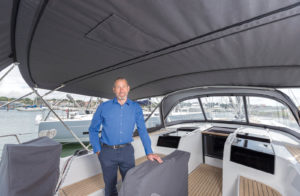John Bland revolutionizes marine fabrication by applying 3-D CAD principles to the design process.

Look at the motor industry—you wouldn’t be happy driving a car that was spec’d 20 years ago,” says John Bland, managing director of Tecsew Ltd., Gosport, Hampshire, U.K. “It’s the same in the textile industry. Whether it’s in the finish, materials or production techniques, we need to move the trade forward.”
In 1981, an 18-year-old Bland launched Tecsew as a part-time business that manufactured boat covers, canopies, sprayhoods (dodgers), biminis and awnings. “I had always wanted to work for myself, be in charge of my own destiny and be involved in a trade where I could make a difference,” Bland says. “I believe we should take what we initially learn and look to advance the process. I’ve never understood anyone in business that, years later, is still doing things the same way as they were initially shown.”
By 1984, the company had grown to be a full-time endeavor when Bland asked his father to come on board, who brought with him expertise from working as a sailmaker in the Royal Navy and later in commercial marine trimming. “For many when you work with your father, you’ve gone into a
pre-existing business,” he says. “That wasn’t the case for me. There was nothing set up beforehand.”
Bland’s father eventually moved on from the business, and in 2006 Bland’s wife Ally came on as financial director, as well as doing sales. To date, there are 13 employees working at Tecsew, and Bland expects all of them to embrace an innovative approach to marine fabrication. “I don’t want staff who are going to be using the same processes 20 years down the line,” he says. “I want to see some of the development come from the staff as well as from me. If they have ideas in terms of improving or changing things I encourage them to bring those ideas on board.”
Computer-added value
For Bland, that kind of forward thinking currently means advancing the use of 3-D CAD (computer-aided design) for marine fabrication. Tecsew had been using a 2-D CAD system since 2001, and approximately seven years ago the company transitioned to using 3-D modeling—a decision that has established the company as an industry leader in innovative 3-D CAD design.

“I believed there had to be a better way of doing things,” Bland says. “I believed 3-D CAD was possible [for marine applications] but as far as I knew it hadn’t been done. I decided to spend the time to learn and develop the process.”
Spending time to learn and develop the process meant that Bland spent uncounted evenings and weekends at home studying and experimenting with designs before he was ready to begin using the process in-house. “The learning curve was very steep to start off with, especially not knowing for sure it could be done,” Bland says. “What we’re doing that’s unique is designing the whole product in CAD, including the frameworks.”
Bland points out that his purpose for making such a big time investment was to add value to the company’s brand, not necessarily to save money. “Initially what we found was that what may have taken six hours labor ended up taking 16 hours labor because of the new skills we were learning,” he says. “But about three years in we started to see savings—and, most importantly, our clients are much happier with the results.”
What makes the clients so satisfied is that they can see a CAD drawing of the product before manufacture ever takes place—and make changes if they don’t like what they see. “There are often compromises to be made in a design,” Bland says. “The beauty of 3-D CAD is that we can show them what compromises may need to be considered and they make the decision before the product is created.”
The result is better design, frames engineered to fold where they need to fold, and clear winches—all while giving the client the heights and spans they require. “We don’t have clients coming back saying they wished a zip had been placed here, a window made larger or to a different profile,” he says. “The client signs off on the product before it’s produced, and after any changes they have requested have
been incorporated.”
Another advantage to 3-D CAD design is the ability to work with clients that are not local, such as those in the United States or Australia. And only one person is required to visit the boat to take the CAD data. “We do not need a second trip with two members of staff to set up the frames and then measure or template,” Bland says. “The first time the frames go down to the boat is when the product is fitted.”
On the field
Although 3-D CAD design has revolutionized the way Bland works with clients, he’s always looking for the next best thing to improve processes—and he would like to see advances made in CAD survey equipment. “We’ve trialed with a lot of companies, and several of them were adamant that their equipment would work out in the field and it doesn’t,” he says. “One of the problems is with the lasers. The surface of the boat is too shiny and there is so much ambient reflective light from the water, and that tends to confuse the lasers—both the boat and the water act like a mirror. What you end up getting are hundreds of images that are like a jigsaw puzzle where all the pieces are completely white, with no detail.”
 The issues for CAD survey equipment are different for marine fabricators than they are for other industries, Bland points out. “Advances we’re seeing are made in terms of precision, so designs are becoming more and more accurate,” he says. “But for us we really only need accuracy to within an eighth of an inch. Rather than make these devices more and more accurate, I’d like the companies to talk to the textile industry and pay attention to what we want—like personal power (battery packs). We need something durable and weatherproof with the extremes in weather we deal with, something easy to set up and work around obstructions on the boat.”
The issues for CAD survey equipment are different for marine fabricators than they are for other industries, Bland points out. “Advances we’re seeing are made in terms of precision, so designs are becoming more and more accurate,” he says. “But for us we really only need accuracy to within an eighth of an inch. Rather than make these devices more and more accurate, I’d like the companies to talk to the textile industry and pay attention to what we want—like personal power (battery packs). We need something durable and weatherproof with the extremes in weather we deal with, something easy to set up and work around obstructions on the boat.”
A database of design
The biggest value for the company as a result of CAD design is its database of designs, Bland says. Everything the company has produced using CAD over the past 15 years is saved as a file. “It takes a lot of the skill out of repeat manufacture,” he says. “Equally as important, when we take more data from the boat we’re able to produce additional products down the road for the client. The initial order may have been for a dodger, but when the client comes back and asks for a bimini, we probably don’t have to revisit the boat. We can produce the bimini from the CAD data we already have.”
Yachting Monthly magazine awarded Tecsew its first 10 out of 10 point score for a reviewed product in October 2015, mainly because of the design process, Bland says. The learning curve may have been steep, but he feels it’s well worth the effort. “You’re in a completely new career if you’re learning CAD design,” Bland says. “I don’t want to embellish it—but it is a whole new skill set and it’s going to take time.”
Precise design
When the U.K. distributor for the Bavaria range of yachts and motorboats needed a sprayhood (dodger) and bimini as standard products for a production boat, the company turned to Tecsew Ltd. to make it happen. The bimini needed to allow for full unhindered operation of all winches, so Tecsew owner John Bland used 3-D CAD to ensure that kind of accuracy. Bland acquired the boat’s measurements using a Proliner, designed the products using the Rhino 3-D modeling program and rendered them in Flamingo. “When designing for a dealer, we are designing what will become a standard product on that particular boat and so it’s very much a case of ‘one size fits all,’” Bland says. “As such it’s very important to design a fully functioning product that will fit the requirements for the majority of buyers.”
Tecsew can also create bespoke designs to specific customer requirements, which it will do with a design surcharge cost applied. “Take the sprayhood, for example,” Bland says. “We have three different models varying in height—one design remains standard and the others are bespoke. These will use the same CAD data but will take extra time in developing the CNC frame bending and cutting files—but there is no requirement for another trip to the boat.”
How can people learn more about 3-D CAD design?
I’ve done presentations for the Marine Fabricators Association (MFA), and much of that information is available on YouTube. In the videos I cover the basics of 3-D CAD design and specific instructions on measuring and designing biminis, cockpit enclosures, sprayhoods (dodgers) and boat canopies.
What is the difference between 2-D and 3-D CAD design for marine fabrication?
For 2-D, what you do is measure or pattern around the frames—measuring or patterning the points on the boat where the canvas is going to go. For instance if you owned a yacht and we bent the framework, then took it down to the boat, we could cut bits off the framework to customize it, but we couldn’t change the radiuses, the curves—the geometry of the framework. With 3-D we can change the geometry of the framework before we manufacture it. We’re drawing on all those services of relevant areas of the boat which enable us to design frames, not just plotting around framework.
5 Top Tips for using 3-D CAD design
- Be prepared to put in a lot of time to learn the process.
- Brush up on your geometry.
- Understand that models take a fair amount of time to generate, and the time savings is on the back end of the process.
- Adjust pricing structures: charge upfront for CAD design in case clients back out.
- Educate clients about 3-D CAD design benefits. The more people who are aware of it, the more people will want it.
 TEXTILES.ORG
TEXTILES.ORG


